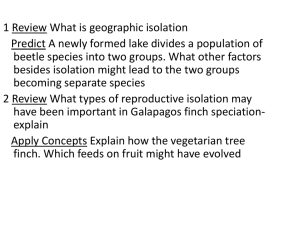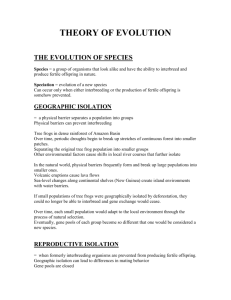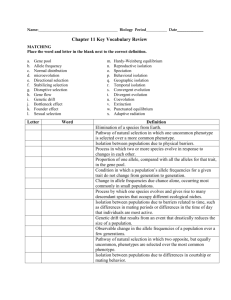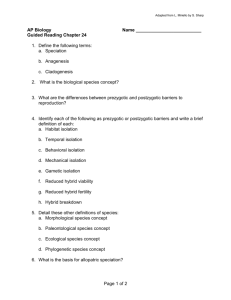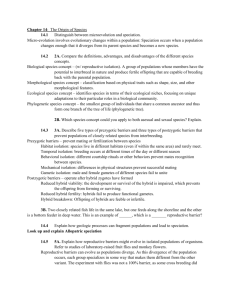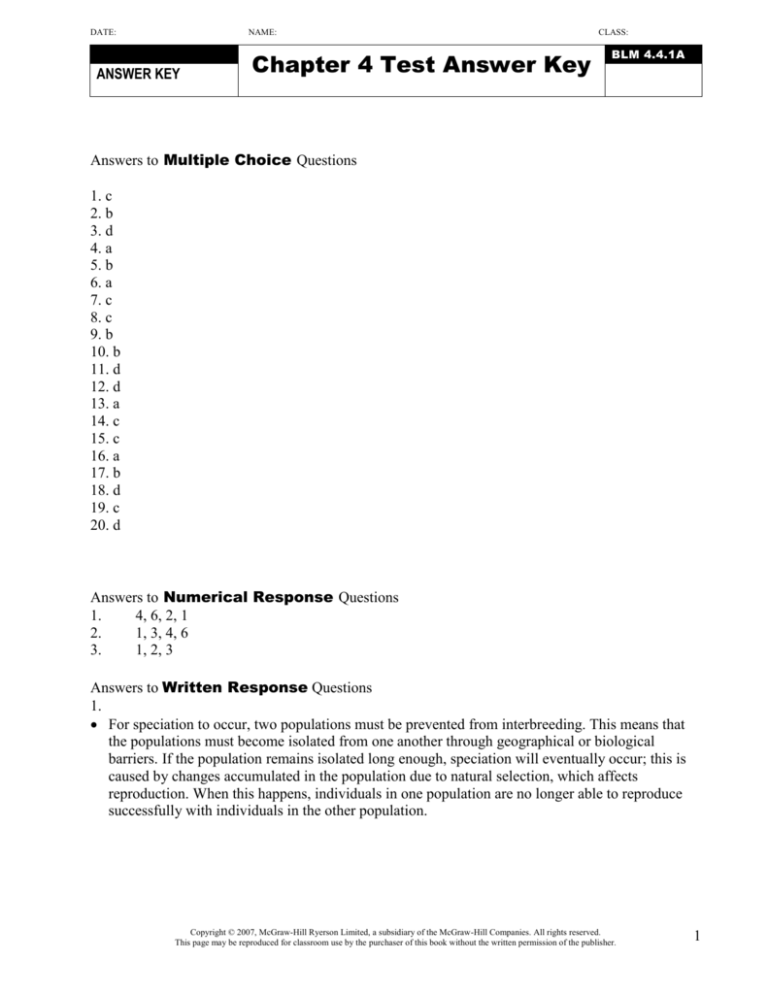
DATE:
NAME:
ANSWER KEY
Chapter 4 Test Answer Key
CLASS:
BLM 4.4.1A
Answers to Multiple Choice Questions
1. c
2. b
3. d
4. a
5. b
6. a
7. c
8. c
9. b
10. b
11. d
12. d
13. a
14. c
15. c
16. a
17. b
18. d
19. c
20. d
Answers to Numerical Response Questions
1.
4, 6, 2, 1
2.
1, 3, 4, 6
3.
1, 2, 3
Answers to Written Response Questions
1.
For speciation to occur, two populations must be prevented from interbreeding. This means that
the populations must become isolated from one another through geographical or biological
barriers. If the population remains isolated long enough, speciation will eventually occur; this is
caused by changes accumulated in the population due to natural selection, which affects
reproduction. When this happens, individuals in one population are no longer able to reproduce
successfully with individuals in the other population.
Copyright © 2007, McGraw-Hill Ryerson Limited, a subsidiary of the McGraw-Hill Companies. All rights reserved.
This page may be reproduced for classroom use by the purchaser of this book without the written permission of the publisher.
1
DATE:
NAME:
ANSWER KEY
Chapter 4 Test Answer Key
CLASS:
BLM 4.4.1A
The geographic isolation of a population does not have to be maintained forever for speciation to
occur. It must be maintained long enough, however, for the population to become reproductively
incompatible with the original population. Even if the populations are reunited, biological barriers
(behavioural, biological) will prevent the two populations from successfully reproducing. In the
case of the shrimp populations, they are fighting now rather than courting.
Natural selection is a process that results when the characteristics of a population of organisms
change because individuals with certain inherited traits survive specific local environmental
conditions and, through reproduction, pass on their traits to their offspring. For natural selection
to occur there must be variety or diversity within the species.
Populations change – not individuals. An abiotic environmental condition can be said to select for
certain characteristics in other individuals. In this way, the environment exerts selective pressure
on a population.
Natural selection does not anticipate a change in the environment (such as the formation of the
land bridge). Instead, natural selection is situational. A trait that at one time seems to have no
particular relevance to survival becomes the trait that later helps the population survive and
reproduce in a changed environment. This trait then persists within a population, because it is
inherited by the offspring of the survivors.
In this example, the land bridge resulted in changing environmental conditions. These conditions
may have applied slightly different selective pressures on the two populations of snapping shrimp.
As a result, each population changed to the point where members of one population are no longer
capable of reproducing with members of the other. In other words, they have developed into two
separate species.
Marking Guide
Score
5
Excellent
Assessment Guidelines
The student ...
constructs a diagram that clearly shows how the geographical
barrier disrupts the flow of genes between the two populations
provides a detailed description of how geographic isolation can
result in the formation of two species
provides a detailed explanation of why geographic isolation does
not have to be permanent; includes indication that biological
barriers will result in continued reproductive isolation
provides a detailed explanation of natural selection
includes a discussion of how natural selection would have formed
the two species of shrimp after the land bridge formed
Copyright © 2007, McGraw-Hill Ryerson Limited, a subsidiary of the McGraw-Hill Companies. All rights reserved.
This page may be reproduced for classroom use by the purchaser of this book without the written permission of the publisher.
2
DATE:
NAME:
Chapter 4 Test Answer Key
ANSWER KEY
4
Good
3
Satisfactory
2
Limited
1
Poor
0
Insufficient
NR
CLASS:
BLM 4.4.1A
constructs a diagram that shows how the geographical barrier
disrupts the flow of genes between the two populations
provides a description of how geographic isolation can result in
the formation of two species
provides an explanation of why geographic isolation does not have
to be permanent; includes indication that biological barriers will
result in continued reproductive isolation
provides an explanation of natural selection
includes a discussion of how natural selection would have formed
the two species of shrimp after the land bridge formed
constructs a diagram that shows how the geographical barrier
disrupts the flow of genes between the two populations
provides a limited description of how geographic isolation can
result in the formation of two species
provides a brief explanation of why geographic isolation does not
have to be permanent
describes natural selection but lacks detail
attempts to explain how natural selection would have formed the
two species of shrimp after the land bridge formed
makes a limited attempt at the diagram
provides a limited description of how geographic isolation can
result in the formation of a new species
provides a limited description of natural selection
provides a limited attempt at explaining how natural selection
works in this example
addresses only two of the bullets at a 2 or a 3 level
does not address the question or provides an answer that is too
brief to assess
does not provide a response
Copyright © 2007, McGraw-Hill Ryerson Limited, a subsidiary of the McGraw-Hill Companies. All rights reserved.
This page may be reproduced for classroom use by the purchaser of this book without the written permission of the publisher.
3




